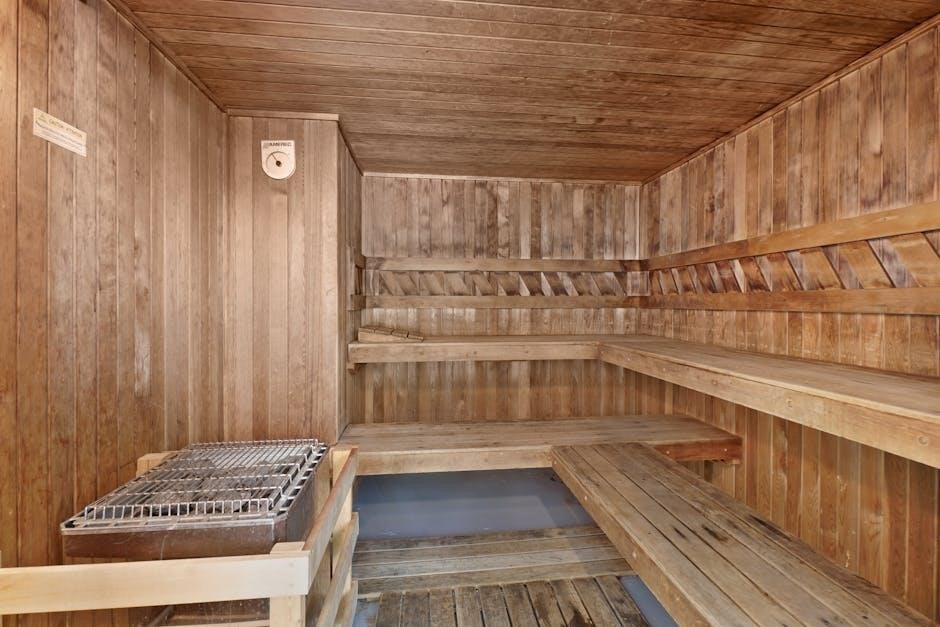
Welcome to our guide on heated floor thermostat instructions! This guide provides a comprehensive overview of installing, programming, and troubleshooting your heated floor system. Learn how to optimize efficiency, comfort, and safety while enjoying the benefits of radiant floor heating.
What is a Heated Floor Thermostat?
A heated floor thermostat is a device designed to regulate the temperature of electric or hydronic radiant floor heating systems. It ensures that the floor reaches and maintains a comfortable temperature while optimizing energy efficiency. These thermostats typically include sensors to monitor floor and ambient temperatures, preventing overheating and ensuring safe operation. They can be programmable or smart, allowing users to set schedules or adjust settings remotely via apps. Some models offer features like floor temperature limits, energy-saving modes, and compatibility with various heating systems. The thermostat acts as the central control unit, enabling precise temperature management and enhancing the overall performance of the heated floor system. By integrating advanced technology, heated floor thermostats provide convenience, comfort, and cost-effective solutions for modern heating needs.
Importance of Proper Thermostat Installation
Proper installation of a heated floor thermostat is crucial for ensuring the system operates safely, efficiently, and effectively. Incorrect installation can lead to inaccurate temperature readings, uneven heating, or even system damage. A well-installed thermostat ensures that the floor heating system runs within safe temperature limits, preventing overheating and potential hazards. It also optimizes energy consumption, reducing utility bills and extending the lifespan of the heating system. Additionally, proper installation guarantees compliance with manufacturer guidelines, maintaining warranty validity and ensuring reliable performance. Improper setup can result in discomfort, higher energy costs, or system malfunctions. Therefore, adhering to installation instructions and seeking professional help when necessary is essential for maximizing the benefits of your heated floor system. A correctly installed thermostat ensures a comfortable, efficient, and safe heating experience for years to come.
Benefits of Using a Programmable Heated Floor Thermostat
A programmable heated floor thermostat offers numerous benefits, enhancing both comfort and energy efficiency. By allowing you to set specific temperature schedules, it ensures your floors are warm when needed and conserve energy when not. This customization reduces unnecessary heating, lowering utility bills and extending system lifespan. Programmable models often include features like energy-saving modes, remote app control, and adaptive learning, which optimize performance based on your habits. These thermostats also provide precise temperature control, preventing overheating and ensuring consistent warmth. Additionally, they can integrate with smart home systems, offering convenience and modern functionality. Overall, a programmable thermostat enhances your heated floor system by delivering tailored comfort, energy savings, and advanced control options, making it a valuable upgrade for any home.

Components of a Heated Floor Thermostat
A heated floor thermostat consists of key components like sensors, displays, and wiring. These parts work together to regulate floor temperature accurately and efficiently, ensuring optimal performance and safety.
Sensors and Their Roles
Sensors are crucial components of a heated floor thermostat, ensuring accurate temperature regulation. The floor sensor measures the floor’s temperature, while the ambient sensor monitors room temperature. These sensors communicate with the thermostat to maintain desired settings.
- The floor sensor is typically placed near heating elements to prevent overheating and ensure even heat distribution.
- Some systems include dual sensors to monitor both floor and air temperature for optimal comfort.
- Sensors can detect malfunctions, such as faulty wiring or extreme temperature deviations, triggering alerts or safety shutdowns.
- Advanced sensors may offer features like floor temperature limits to prevent damage to flooring materials.
Proper sensor installation and calibration are essential for reliable performance, ensuring your heated floor system operates efficiently and safely.
Display and Controls Overview
The display and controls of a heated floor thermostat are essential for user interaction and system management. Most thermostats feature an LCD screen that shows current temperature, settings, and status messages. Premium models may include a touchscreen interface for easier navigation.
Key controls typically include:
– Temperature adjustment buttons to set desired heat levels.
– Menu navigation buttons to access programming options and system settings.
– A power button to turn the system on or off.
Some advanced models offer backlit displays for better visibility in low-light conditions. The display also provides feedback, such as error codes or status alerts, helping users troubleshoot issues. Controls may vary depending on the thermostat’s complexity, but they are designed to be intuitive for seamless operation.
Wiring and Compatibility
Proper wiring and compatibility are critical for the safe and efficient operation of a heated floor thermostat. Most thermostats are designed to work with either 120V or 240V systems, depending on the heating system’s requirements. Always ensure the thermostat’s voltage rating matches your floor heating setup.
The thermostat typically requires a dedicated electrical circuit to prevent overload. Wiring must follow local electrical codes, and it’s recommended to hire a licensed electrician if you’re unsure. Compatibility also extends to the type of heating system, such as electric mats, hydronic systems, or radiant panels.
Check the thermostat’s maximum load capacity to ensure it can handle your system’s power requirements. Misalignment can lead to overheating or poor performance. Proper wiring connections are essential to avoid malfunctions or safety hazards. Always refer to the manufacturer’s guidelines for specific compatibility and wiring instructions.

Installation Instructions
Follow these steps to ensure a safe and proper heated floor thermostat installation. Begin by turning off the power supply. Secure the floor sensor between heating wires. Mount the thermostat and connect wires according to the manufacturer’s guide. Avoid crossing wires over heating elements; Double-check all connections before restoring power.
Pre-Installation Checklist
Before starting the heated floor thermostat installation, ensure the following steps are completed:
Turn off the power supply to the heating system at the circuit breaker.
Verify the thermostat is compatible with your heated floor system and voltage requirements.
Ensure all components, including the thermostat, floor sensor, and mounting hardware, are included in the package.
Choose a suitable location for the thermostat, ensuring it’s accessible and not exposed to direct sunlight or moisture.
Check the floor sensor placement, ensuring it’s positioned between heating wires and at least 1 foot into the heating area.
Verify the thermostat is rated for your system’s voltage (120V or 240V).
Ensure the area around the thermostat and sensor is clear of debris.
Mark the installation location on the wall or floor for accurate placement.
Consult the user manual for specific manufacturer recommendations.
If unsure, consider consulting a licensed electrician.
By completing this checklist, you’ll ensure a safe and successful installation process.
Wiring the Thermostat
Wiring your heated floor thermostat requires careful attention to ensure safe and proper operation. Begin by turning off the power to the heating system at the circuit breaker. Locate the thermostat wiring terminals, typically labeled as R, W, G, C, or similar, depending on the model. Strip the wires to the recommended length and connect them to the corresponding terminals, ensuring no loose connections. For systems with a floor sensor, connect the sensor wires to the designated terminals (usually labeled “Sensor” or “S”). Double-check the wiring diagram in the user manual to confirm compatibility with your system’s voltage (120V or 240V). Once all connections are secure, turn the power back on and test the system to ensure it responds correctly. If unsure, consult a licensed electrician to avoid potential hazards. Proper wiring is critical for optimal performance and safety.
Installing the Floor Sensor
The floor sensor is a crucial component for maintaining optimal temperatures in your heated floor system. Begin by locating the ideal position for the sensor, typically halfway between two heating wires and at least 12 inches into the heating area. Avoid placing it near edges or under heavy furniture. Use a drill or sharp object to create a small pilot hole in the floor for the sensor tip. Gently feed the sensor wire through the hole, ensuring it lies flat and secure. Secure the sensor tip with hot glue or tape to prevent movement. Do not cross over heating wires, as this can cause inaccurate readings. Once installed, test the sensor by setting a higher temperature and verifying the system responds. Proper placement ensures accurate temperature readings and efficient heating. Always follow the manufacturer’s guidelines for installation to avoid damage or malfunction.
Mounting the Thermostat
Mounting the thermostat is a straightforward process that requires careful planning to ensure proper functionality. Begin by selecting a suitable location for the thermostat, typically on a wall at a height of 4-5 feet to ensure accurate temperature readings. Use a level to mark the wall for straight installation. If your thermostat comes with a mounting plate, attach it to the wall using screws or anchors provided. Gently place the thermostat onto the mounting plate, ensuring it clicks securely into place. For models without a plate, follow the manufacturer’s specific instructions for direct wall mounting. Once mounted, connect the wires to the corresponding terminals, double-checking the wiring diagram to avoid errors. Tighten all connections firmly and replace any covers or faceplates. Finally, test the thermostat by turning on the power and verifying that it responds to temperature adjustments. Proper mounting ensures reliable performance and easy access for programming and maintenance. Always refer to the manufacturer’s guidelines for specific installation requirements.
Initial Testing and Setup
After successfully mounting and wiring your thermostat, proceed with the initial testing and setup to ensure everything functions correctly. Start by turning on the power supply to the thermostat and verify that the display lights up and shows the correct default settings. Check for any error codes or abnormal displays, which may indicate wiring issues or sensor malfunctions. If the thermostat is programmable, set the current date and time accurately. Test the heating system by adjusting the temperature settings and observing if the floor heating activates as expected. Use the thermostat’s built-in test mode, if available, to simulate different operating conditions. Ensure the floor sensor is providing accurate temperature readings by comparing it with a separate thermometer. Finally, review the user manual for specific setup instructions, such as enabling energy-saving features or setting temperature limits. Proper initial testing ensures your heated floor system operates efficiently and safely from the start. Always refer to the manufacturer’s guidelines for detailed setup procedures.

Programming the Thermostat
Programming your heated floor thermostat allows you to customize temperature settings, schedules, and energy-saving features. Set temperature limits, create weekly schedules, and enable energy-saving modes for optimal performance. Refer to the manual for detailed steps.
Setting Temperature Limits
Setting temperature limits on your heated floor thermostat is crucial for safety and comfort. The operating range is typically between 61°F (16°C) and 104°F (40°C). To set limits, access the settings menu, often labeled as “Temperature Limits” or “Floor Settings.” Use the up and down arrows to adjust the maximum temperature, ensuring it doesn’t exceed 104°F to prevent overheating. The thermostat usually handles lower limits automatically, starting heating if the floor temperature drops below 40°F. However, you can set a custom lower limit if desired. After adjusting, save your settings, often by pressing and holding a button or navigating back to the main menu. This ensures your floor remains comfortable and energy-efficient, while also preventing potential hazards. Always test your settings to confirm they work as expected.

Creating a Weekly Schedule
Programming a weekly schedule for your heated floor thermostat allows you to customize when and how your system operates. Most thermostats offer two programs: P1 for weekdays (Mon-Fri) with four events, and P2 for weekends (Sat-Sun) with four events. To create a schedule, press the “Day” button to cycle through the days and select the desired program. Use the arrows to set the start times for heating periods, ensuring the system activates before you wake up or return home. Once set, the thermostat will automatically adjust temperatures based on your schedule. This feature helps save energy by turning off the heat when you’re away or sleeping. After configuring, press and hold the button to save your settings. A well-programmed schedule ensures your floors are warm and comfortable while minimizing energy usage. This feature is especially useful for maintaining consistent temperatures without manual adjustments.
Understanding the Cycle Rate
The cycle rate on your heated floor thermostat refers to how frequently the heating system turns on and off to maintain the desired temperature. This rate is crucial for achieving both efficiency and comfort. For example, a cycle rate of 6 minutes on and 9 minutes off means the system operates for 6 minutes out of a 15-minute cycle. A shorter cycle rate (e.g., 1 minute on and 14 minutes off) is ideal for maintaining a consistent temperature in well-insulated spaces, while a longer cycle rate is better suited for larger or less insulated areas. Adjusting the cycle rate helps prevent overheating and ensures energy savings. Always consider the thermal mass of your floor and the insulation of your room when setting this feature. Most thermostats allow you to customize the cycle rate during initial setup. Balancing the cycle rate properly ensures optimal performance and energy efficiency without compromising comfort.
Energy-Saving Features

Modern heated floor thermostats are designed with energy efficiency in mind, offering features that help reduce energy consumption without compromising comfort. Programmable schedules allow you to customize heating times, ensuring the system operates only when needed. For example, you can set the thermostat to lower temperatures when you’re asleep or away from home. Many thermostats also include a floor temperature limit, preventing overheating and potential damage to your flooring. Additionally, some models feature adaptive learning, which adjusts heating cycles based on your usage patterns, optimizing energy use. Energy-saving modes can further reduce consumption by minimizing unnecessary heating. Always look for thermostats with an energy-efficient rating or smart features to maximize savings. Regularly reviewing your energy usage and adjusting settings can also help maintain optimal efficiency. These features ensure your heated floor system is both cost-effective and environmentally friendly.

Troubleshooting Common Issues
Identify and resolve common problems with your heated floor thermostat, such as error codes, sensor malfunctions, or system shutdowns. Resetting the thermostat or checking sensor connections often fixes issues quickly.
Error Codes and Their Meanings
Error codes on your heated floor thermostat indicate specific issues. For example, an “E1” code may signal a sensor malfunction, while “FLOOR LIMIT” alerts indicate the floor temperature exceeds safe levels (typically above 104°F). Understanding these codes is crucial for quick resolution. Common codes include temperature range errors, sensor faults, or system overloads. Refer to your thermostat’s manual for code definitions, as they vary by model. To resolve issues, reset the thermostat or check sensor connections. Ensure the floor temperature is within the operating range (32°F to 120°F). Addressing these codes promptly prevents damage and ensures optimal performance. Always follow manufacturer guidelines for troubleshooting and repairs.
Sensor Malfunction Solutions
If your heated floor thermostat indicates a sensor malfunction, start by checking the sensor’s placement. Ensure it is securely attached to the floor, halfway between heating wires, and at least 1 foot into the heating area. Verify that no wires cross over the sensor. Clean any debris and secure the sensor with hot glue if necessary. If issues persist, test the sensor’s resistance using a multimeter to ensure it matches the manufacturer’s specifications. Replace the sensor if damaged or faulty. Reset the thermostat after addressing the sensor to clear error codes. Always follow the manufacturer’s instructions for sensor installation and maintenance to prevent future malfunctions. Proper sensor function is critical for accurate temperature control and system efficiency.
Resetting the Thermostat
Resetting your heated floor thermostat can resolve various issues, such as error codes or sensor malfunctions. Start by turning off the power to the thermostat at the circuit breaker or fuse box. Wait 30 seconds to ensure all components are fully powered down. Turn the power back on and check if the thermostat functions correctly. If the issue persists, press and hold the reset button (if available) for 5-10 seconds. Some models may require pressing a combination of buttons or navigating through the menu to reset. After resetting, the thermostat will revert to factory settings, so you may need to reprogram your preferences. Always refer to your user manual for model-specific instructions. If the problem remains unresolved, contact a professional for assistance. Regular resets can help maintain optimal performance and address unexpected system behavior.

Maintenance and Upkeep
Regular maintenance ensures your heated floor system operates efficiently. Clean the thermostat and sensors, update software, and inspect wiring annually. Proper upkeep prolongs system life and performance.
Regular Checks for Optimal Performance
Regular checks are essential to ensure your heated floor system runs smoothly. Start by inspecting the thermostat’s display for any error codes or malfunctions. Check the floor sensors to ensure they are securely fastened and not damaged. Verify that all wiring connections are tight and free from corrosion. Additionally, review your programmed schedules to confirm they align with your daily routine and preferences. Clean the thermostat’s interface and sensors to prevent dust buildup, which can interfere with accuracy. Test the system by running a manual cycle to ensure the floor heats up evenly and within the set temperature range. Finally, update the thermostat’s software or firmware if any new versions are available, as updates often improve functionality and resolve potential issues. By performing these checks, you can maintain optimal performance and extend the lifespan of your system.
Cleaning the Thermostat
Cleaning your heated floor thermostat is a simple yet crucial step to ensure accurate temperature control and optimal performance. Begin by powering off the thermostat at the circuit breaker to avoid any accidental activation. Use a soft, dry cloth to gently wipe the display and controls, removing dust or debris that may interfere with functionality. For tougher stains or grime buildup, lightly dampen the cloth with water, but avoid harsh chemicals or abrasive materials that could damage the screen or components. Pay special attention to the sensors, as dust or dirt can affect their accuracy. Regular cleaning prevents malfunctions and ensures precise temperature readings. Additionally, inspect the thermostat’s casing for dust accumulation and clean it to maintain proper airflow. By incorporating this maintenance into your routine, you can keep your heated floor system running efficiently and reliably.
Updating Software or Firmware

Keeping your heated floor thermostat software or firmware up to date is essential for optimal performance and security. Regular updates often include new features, bug fixes, and improved compatibility. To update, first, check the manufacturer’s website or app for the latest version. Ensure your thermostat is connected to Wi-Fi or another compatible update method. Download the update and follow the on-screen instructions to install it. Avoid interrupting the process, as this could cause system issues. Some thermostats may require manual updates via a USB port, using files downloaded from the manufacturer’s site. After installation, restart the thermostat to apply changes. Always back up your settings before updating to prevent data loss. If unsure, consult the user manual or contact customer support for assistance. Regular updates ensure your heated floor system operates efficiently and securely.
Thank you for following our guide on heated floor thermostat instructions! For further assistance, visit the manufacturer’s website or contact their customer support. Refer to the user manual for detailed troubleshooting and maintenance tips. Happy heating!
Final Tips for Efficient Use

To maximize the efficiency and longevity of your heated floor system, follow these final tips:
– Program wisely: Use the programmable features to schedule heating only when needed, saving energy and reducing wear.
– Maintain optimal temperatures: Set the thermostat between 61°F and 104°F (16°C to 40°C) for comfort and safety.
– Monitor sensor accuracy: Ensure floor sensors are correctly placed and functioning properly to avoid overheating or underheating.
– Regularly clean the thermostat: Dust and debris can affect performance, so clean the display and controls periodically.
– Update software: Stay informed about firmware updates to access new features and improvements.
– Inspect wiring annually: Check for loose connections or damage to prevent system malfunctions.
By following these tips, you’ll enjoy a comfortable, energy-efficient, and long-lasting heated floor system.